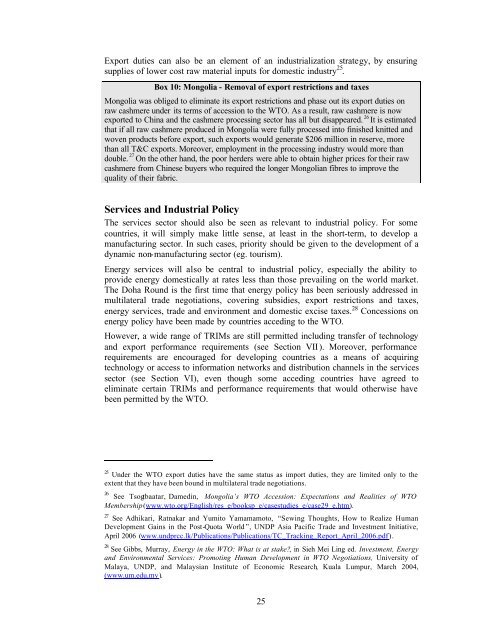Trade Policy Note Final-rev08 - Development
Trade Policy Note Final-rev08 - Development
Trade Policy Note Final-rev08 - Development
Create successful ePaper yourself
Turn your PDF publications into a flip-book with our unique Google optimized e-Paper software.
Export duties can also be an element of an industrialization strategy, by ensuring<br />
supplies of lower cost raw material inputs for domestic industry 25 .<br />
Box 10: Mongolia - Removal of export restrictions and taxes<br />
Mongolia was obliged to eliminate its export restrictions and phase out its export duties on<br />
raw cashmere under its terms of accession to the WTO. As a result, raw cashmere is now<br />
exported to China and the cashmere processing sector has all but disappeared. 26 It is estimated<br />
that if all raw cashmere produced in Mongolia were fully processed into finished knitted and<br />
woven products before export, such exports would generate $206 million in reserve, more<br />
than all T&C exports. Moreover, employment in the processing industry would more than<br />
double. 27 On the other hand, the poor herders were able to obtain higher prices for their raw<br />
cashmere from Chinese buyers who required the longer Mongolian fibres to improve the<br />
quality of their fabric.<br />
Services and Industrial <strong>Policy</strong><br />
The services sector should also be seen as relevant to industrial policy. For some<br />
countries, it will simply make little sense, at least in the short-term, to develop a<br />
manufacturing sector. In such cases, priority should be given to the development of a<br />
dynamic non-manufacturing sector (eg. tourism).<br />
Energy services will also be central to industrial policy, especially the ability to<br />
provide energy domestically at rates less than those prevailing on the world market.<br />
The Doha Round is the first time that energy policy has been seriously addressed in<br />
multilateral trade negotiations, covering subsidies, export restrictions and taxes,<br />
energy services, trade and environment and domestic excise taxes. 28 Concessions on<br />
energy policy have been made by countries acceding to the WTO.<br />
However, a wide range of TRIMs are still permitted including transfer of technology<br />
and export performance requirements (see Section VII). Moreover, performance<br />
requirements are encouraged for developing countries as a means of acquiring<br />
technology or access to information networks and distribution channels in the services<br />
sector (see Section VI), even though some acceding countries have agreed to<br />
eliminate certain TRIMs and performance requirements that would otherwise have<br />
been permitted by the WTO.<br />
25 Under the WTO export duties have the same status as import duties, they are limited only to the<br />
extent that they have been bound in multilateral trade negotiations.<br />
26 See Tsogtbaatar, Damedin, Mongolia’s WTO Accession: Expectations and Realities of WTO<br />
Membership (www.wto.org/English/res_e/booksp_e/casestudies_e/case29_e.htm).<br />
27 See Adhikari, Ratnakar and Yumito Yamamamoto, “Sewing Thoughts, How to Realize Human<br />
<strong>Development</strong> Gains in the Post-Quota World ”, UNDP Asia Pacific <strong>Trade</strong> and Investment Initiative,<br />
April 2006 (www.undprcc.lk/Publications/Publications/TC_Tracking_Report_April_2006.pdf).<br />
28 See Gibbs, Murray, Energy in the WTO: What is at stake?, in Sieh Mei Ling ed. Investment, Energy<br />
and Environmental Services: Promoting Human <strong>Development</strong> in WTO Negotiations, University of<br />
Malaya, UNDP, and Malaysian Institute of Economic Research, Kuala Lumpur, March 2004,<br />
(www.um.edu.my).<br />
25
















